How far does reason serve to cure, or at least to palliate, the miseries of humankind? Not very far, according to Samuel Johnson:
The cure for the greater part of human miseries is not radical, but palliative. Infelicity is involved in corporeal nature and interwoven with our being. All attempts, therefore, to decline it wholly are useless and vain: the armies of pain send their arrows against us on every side, the choice is only between those which are more or less sharp, or tinged with poison of greater or less malignity; and the strongest armor which reason can supply will only blunt their points, but cannot repel them. —Rambler, no. 32
Johnson wrote this partially in response to the Stoics, who professed to be able to ignore misery, and to maintain equipoise when faced with calamity. But he, as someone who valued reason, was also exploring the limits of reason. Reason cannot cure every ill:
The great remedy which heaven has put in our hands is patience, by which, though we cannot lessen the torments of the body, we can in a great measure preserve the peace of the mind, and shall suffer only the natural and genuine force of an evil without heightening its acrimony or prolonging its effects. —Rambler, no. 32
Thus, says Johnson, patience and not reason serves to maintain our peace of mind when we are confronted with misery, torment, and suffering.

